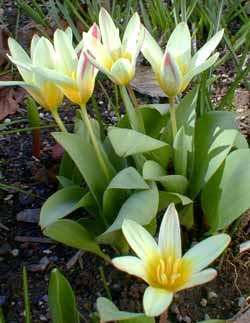
Wild Kaufmanniana
Water-Lily Tulips
"O, Tulip, come & learn
the rainbow colors of my face."
-An Endless Celebration
of the Arms of the Beloved
by Jalaluddin Rumi
(1207-1273)
of the Arms of the Beloved
by Jalaluddin Rumi
(1207-1273)
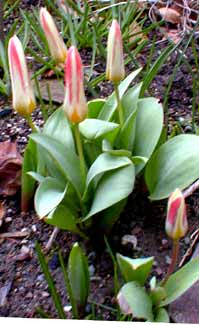 Tulipa kaufmanniana, native of Turkey, used to be (by a long shot) the first of our species tulips to bloom, starting as slender candlestick buds at February's end, & unfolding into full bloom by the first week in March, hence a winter bloomer even though usually categorized as early spring. In 2004 however, the Violet Crocus Tulip (T. humilis violacea) bloomed a week sooner than our wild Kaufmanniana, then in 2005 with many more kaufmannianas in the garden, three cultivars bloomed simultaneous with the wild ones.
Tulipa kaufmanniana, native of Turkey, used to be (by a long shot) the first of our species tulips to bloom, starting as slender candlestick buds at February's end, & unfolding into full bloom by the first week in March, hence a winter bloomer even though usually categorized as early spring. In 2004 however, the Violet Crocus Tulip (T. humilis violacea) bloomed a week sooner than our wild Kaufmanniana, then in 2005 with many more kaufmannianas in the garden, three cultivars bloomed simultaneous with the wild ones.The blooms, when first beginning to open, are rather cup-shaped, though with pointy petals; but eventually, upon the sunniest days, they open flat from about a third of the way up the slender cup, so that when viewed from above they look like hexagonal stars. The petals are slenderer on the wild form than on the cultivars. These will persist into April, as they are extremely long-lasting.
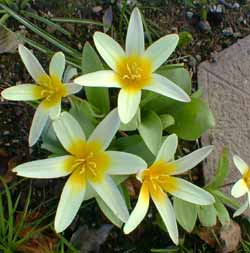 When the reflexing petals are fully opened it is obvious why they are called "waterlily type." When the flowers are closed, they show the outer colors. The second photo shows them a couple days after the first photo, & because the day was overcast, the blooms closed back up, showing more of their darkening pink outer edges.
When the reflexing petals are fully opened it is obvious why they are called "waterlily type." When the flowers are closed, they show the outer colors. The second photo shows them a couple days after the first photo, & because the day was overcast, the blooms closed back up, showing more of their darkening pink outer edges.The third photo shows them on a very sunny morning. Viewed from above the pink of the outer petals is no longer visible, & it appears as pale creamy yellow with deep yellow heart.
For some kaufmannianas, the leaves provide added interest by right of being either mottled or red-striped, elsetimes wavy, or both wavy & striped. Strips & mottling originated in cross-fertilizations with T. greigii, as the purest examples of the wild form (such as shown on this page) do not have the mottling or stripes. You can see a very stripy water-lily tulip on the T. kaufmanniana 'Heart's Delight' page.
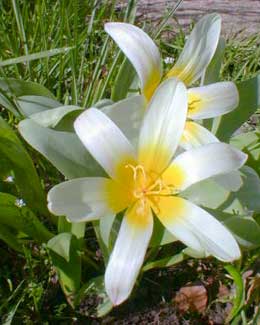 This faintly fragrant creamy yellow wildflower, with a rosy blush to the outer petal points & edges, was first described in 1877, & was given the First Class Certification by the Royal Horticultural Society in 1897. Several other color varieties have since come into gardening, but this one remains the ideal of the "kaufmanniana Type" or "Water Lily Type" tulip. They vary in height & size of bloom, but the leaves are rather close to the ground, while the large blossom lifts to six or eight inches. Some may stay as short as four inches, & rarely there's a twelve-incher.
This faintly fragrant creamy yellow wildflower, with a rosy blush to the outer petal points & edges, was first described in 1877, & was given the First Class Certification by the Royal Horticultural Society in 1897. Several other color varieties have since come into gardening, but this one remains the ideal of the "kaufmanniana Type" or "Water Lily Type" tulip. They vary in height & size of bloom, but the leaves are rather close to the ground, while the large blossom lifts to six or eight inches. Some may stay as short as four inches, & rarely there's a twelve-incher.When the blooms are spent, the remaining & soon-fading leaves are rather homely, yet should not be trimmed until they begin to yellow & brown, as until they are browning, the leaves are recharging the bulb for the next year.
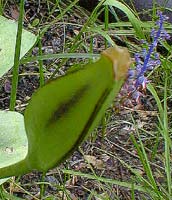 Though they are such short tulips that one would think they'd be impervious to "lodging" or falling over, a hard rain or wind does knock them right down, so they require a somewhat protected position to look their best, or even a bit of crowding. Some of the cultivars are better at remaining upright than the wild form, & are also of a more robust appearance with broader petals; but even the wild one, which may lean over on overcast days, will perk back up on sunny days.
Though they are such short tulips that one would think they'd be impervious to "lodging" or falling over, a hard rain or wind does knock them right down, so they require a somewhat protected position to look their best, or even a bit of crowding. Some of the cultivars are better at remaining upright than the wild form, & are also of a more robust appearance with broader petals; but even the wild one, which may lean over on overcast days, will perk back up on sunny days.Kaufmanniana likes to have its bulbs planted relatively deep in autumn, a full six inches down, so conceivably shallower bulbs could be layered over them, baring in mind that the kaufmannians appear very early & have large leaves that would smother anything tiny.
Once they're established, kaufmannianas do not like to be disturbed, so their area must be marked well so that they are not accidentally dug up. Unmolested, all kaufmannianas perennialize with great ease, though generally only this wild form will fully naturalize, slowly colonizing & spreading out over a small area.
The last photo shows the green kaufmanniana seed pod getting started at April's end (2003). These generally occur only on the wild form, & have a decorative quality of their own.